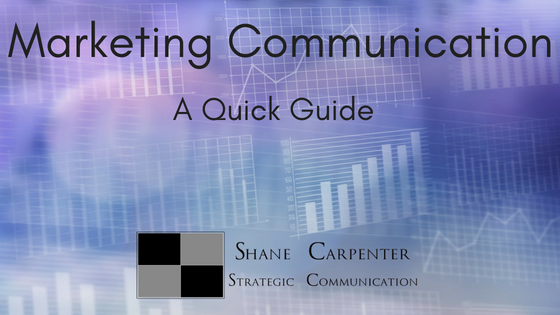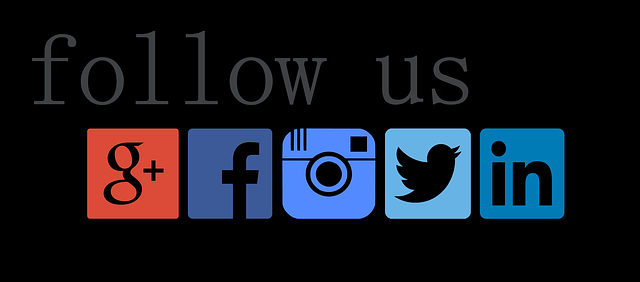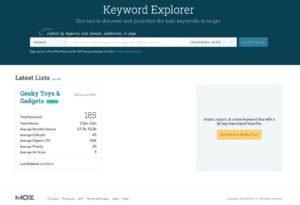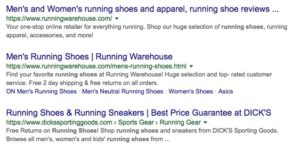
Marketing communication has changed dramatically over the years. There was a time when we had fewer options. You could run an advertisement or have a special event to get attention and cultivate leads. It’s not like that anymore. Sure you can still do those things but only doing those things is kind of like bringing a ten-speed bike to a drag race against a Dodge Charger. You will have shown up but it’s pretty obvious the Dodge Charger will win.
There are more options at our disposal that allow us to reach more people than ever. It doesn’t stop there. We have the power to get in front of the right person in the right place at the right time. No more placing an ad and hoping the right person sees it.
There may be more choices than ever but it’s also noisier than ever which still makes it challenging to reach our customers. However, with some research, the right strategy, some creativity, and a lot of work we can achieve success on a level that would make a marketer from 20 years ago extremely jealous.
This is a quick guide to marketing communication. It’s designed to be short and to the point with information that will help you make informed decisions on how to market your business.
Marketing communication involves some trial and error. There are no shortcuts or easy fixes. It is a process and it will take time to achieve results if you’re willing. Let’s start with a basic question.
What is Marketing Communication?
Marketing communication is a fancy way of describing the collision between marketing and public relations. The two used to be separate from each other but this has changed in recent years. Marketing used to sell while public relations developed relationships and awareness. In this day and age, these two disciplines can no longer live on separate islands. The two have, and will continue to move closer to each other in the future.
The most dramatic change for those of us that practice public relations is not only that we have to be marketers as well, but that we can measure results. In the past public relations has done a poor job of measuring results. This has changed for the better. We can now measure the business we drive for an organization. In the end, what matters more than meeting goals and achieving results?
Options

As I said at the top, we have more options than ever. Here’s a list of some of the things you should be considering in your marketing communication efforts:
- Social Media (Facebook, Twitter, Instagram, Snapchat, LinkedIn, YouTube, Pinterest)
- Media Relations (television, newspapers, magazines, radio, blogs)
- Owned Content (The content on your website)
- Paid Media (ads on social media networks)
- Search Engine Optimization (SEO)
- Pay Per Click (PPC)
- Search Engine Marketing (SEM)
Everything has to work together so it is like putting together a puzzle. You have to know what channel should be used to reach your audience. None of what I listed even takes into account traditional advertising channels.
We have to stay on top of the newest trends as the platforms we use are always changing and adjusting. Google is constantly tweaking its algorithm. Facebook re-prioritized what content we see in our news feed. Organizations who centered their strategies around Facebook were left out in the cold when Facebook changed its own strategy. The changes Facebook made were disruptive enough to drive them out of business.
As if that is not enough we have to optimize for both desktop and mobile. Over 66% of the traffic to my website is from a mobile device. Mobile itself has to take into consideration both phones and tablets as they will present your website in different ways.
Keeping up with everything I mentioned is a full-time job in itself and it can feel overwhelming (yes, for me too) but it is crucial to your marketing communication efforts.
Social Media

Most of the traffic I get on my website comes from social. Every time I post an article to my blog I share it on Facebook, Twitter, LinkedIn, and Google+. At the moment Twitter and LinkedIn drive the majority of my website traffic. For you, it may be different but you should have some sort of social media presence. That said, social is only a piece of a larger marketing communication strategy. It is not a strategy in and of itself. I’ll talk about that more later.
Facebook seems almost synonymous with social media but there are other platforms to consider as well and all can help drive business results. Instagram is exploding right now. Video is also becoming a big driver for businesses so you should at least consider YouTube.
Let’s take a quick look at some of the top social media platforms that you can use for your marketing communication efforts.
With over 2 billion users, Facebook is the 800 lb. gorilla of the social media world. Despite the recent scandals, Facebook remains the most popular social media platform. It’s for this reason, I strongly suggest if you only are active on one social media platform for your marketing communication efforts that it be Facebook.
Facebook is a powerful platform but it all comes down to you. How you differentiate your business and the kind of content that you share and how you engage your followers are going to determine the impact it has. If you remember nothing else from the previous sentence remember this: engage your followers. It should be an active process, not a passive one.
Remember earlier when I said that video was a big driver and you should consider YouTube? That hasn’t gone unnoticed by Facebook or any of the other social media platforms. I see about as many videos in my news feed as pictures these days. It doesn’t have to be HD quality but it does need to provide some value to your audience.
Facebook, along with its rival Google, dominates the digital ad world. Because of the information that users share on the platform, you are able to run ads that hyper-target the audience you want to reach. You will see more value from a well-executed Facebook ad than you would spending millions running a commercial during the Super Bowl. It’s a hidden gem of the platform and it shouldn’t be overlooked.
Facebook may have run into difficulties lately but don’t tell that Instagram. The Facebook-owned company boasts 813 million users and continues to see tremendous growth. Instagram is rather simple to use. Posts can be pictures or video. Video can be 3 to 60 seconds in length. Filters and captions can be applied to posts as a well as hashtags allowing users to find posts via a topic.
Instagram added a feature called “Stories” to compete with Snapchat. A story can string together pictures and video. The success of Instagram stories has helped the platform surpass Snapchat in daily users and time spent in the app. Like the other platforms, ads can be created that allow you to target a specific group.
There are 500 million tweets sent on Twitter every day. This adds up to 200 billion per year. Not surprisingly, Twitter is known as the place where news breaks. What makes Twitter unique is that it limits the number of characters one can use when posting. A tweet is limited to 280 characters. This includes any URLs that you put in the tweet (as well as spaces). On this platform, you need to be on point. There is a certain creativity that is required to do this in a way that engages people.
Twitter has a timeline which functions like the Facebook news feed. Media such as pictures and video can be shared as well as URLs to content. People can reply, like, and share tweets. Like Facebook, you can run ads that target your ideal audience.
Snapchat
Snapchat doesn’t have as many users as the other platforms but if your business is trying to reach teens or young adults, you need to take a look at Snapchat. It is the most popular social media platform amongst teens.
Snapchat has some key differences from the other social media platforms. First, it’s only available for mobile. More specifically, it’s only for iOS and Android smartphones. Second, the messages are ephemeral meaning they are only available for a short period of time.
Pictures or video, called Snaps, are taken and can be shared with everybody on the platform or just friends. Users can also subscribe to brand accounts (Rolling Stone, Ford, etc). It’s worth noting that there are companies who are creating great content for Snapchat. Snapchat Stories functions much the same as the previously discussed Instagram Stories. Ad content can be created and runs between Snap Stories.
LinkedIn is the social network for professionals. Users can create a digital resume and connect with other professionals, follow influencers, search for jobs, and take classes. It has a newsfeed like the other platforms but the content is aimed at the professional. You won’t see cute cat pictures on LinkedIn.
LinkedIn Pulse allows you to create blog posts on the platform. If you are writing articles that are aimed at professionals, using LinkedIn Pulse is a worthwhile endeavor that will show your expertise and build relationships with other business professionals. The platform has also moved to embrace video by allowing users to upload video content via its iOS and Android apps.
SEO
SEO is a must for websites. It involves using keywords or phrases so when people are doing a search on Google, or any other search engine, your website will come up in the results. The traffic you receive from these searches is referred to as “organic” because it was their own search that drove them to your site. Let’s look at a quick example.
If your business is selling cars, you could use the keyword “cars”. But let’s say you sell Ford cars, you can make your keyword more specific by using “Ford cars”. Of course, Ford has thousands of dealerships around the world so using that term probably is going to help get you to page one of Google which is the goal. A better keyword phrase might be, “Ford cars in Spokane Washington”.
The goal isn’t necessarily to be more specific but to use the terms your customers are using. To do this you will have to do keyword research. There are many tools out there that will help you conduct this research. One of the most popular is Moz which offers some free tools to do a limited amount of research (usually 30 searches in a month).

Keyword research takes time. I usually make a content map that shows all the articles I am going to write on a topic. It’s not unusual for me to spend several hours researching for just for a few articles. If done right, your efforts will be rewarded with new website traffic that can be turned into leads.
SEO is also impacted by domain authority (DA). The higher your website’s DA, the better you are going to rank on Google. Remember the goal is to be on page one for a topic. Moz also has tools to determine your DA and those websites using the same keyword/phrase that you are using.
There are other niches to consider with SEO such as local SEO which will help you show up on maps.
PPC
PPC, or cost per click is what is known as paid search. They are those paid ads you see at the top of your search results. Google’s program for paid search is called Google Ads (formerly known as AdWords). It allows you to select the keywords that customers are using (like SEO) and then turns this into an ad. If somebody clicks on your ad, then you pay a certain amount. If they ignore your ad, you don’t have to pay anything. The cost for Google Ads is determined by how popular the keyword is. The more popular the higher the cost. If you have the budget, it is something to consider. If not, I suggest focusing on SEO.

SEM
I didn’t understand the difference between SEM and SEO for the longest time. Finally one day I read an article that offered a clear-cut explanation. SEO and PPC are both components of SEM. It was so simple I felt like an idiot for not getting it before. Essentially SEO (organic) + PPC (paid) = SEM.

The Rise of PESO
The PESO model was developed by Gini Dietrich. It’s a game changer. It organized our activities into four primary areas and then added the ingredient that was lacking in the marketing communication world: Measurement. PESO is an acronym that stands for:
- Paid Media
- Earned Media
- Shared Media
- Owned Media
Owned Media
You may be thinking, “It’s called PESO. Why is he starting with the ‘O’?” Simply put, owned media is the centerpiece of the PESO model. It should be the center of your marketing communication efforts. Everything else serves to push people back to your website. Why is that important? Your website is like the storefront for your business online. If leads aren’t coming to the store, you’re not going to be able to turn them into customers.
Yes, you can input your business information on your Facebook page (and you should) but Facebook’s primary purpose is making money for Facebook, not you. This is why organizations that had Facebook at the center of their marketing communication strategy went out of business. When Facebook made a change that prioritized individuals over pages, the companies that put all their eggs in the Facebook basket saw huge decreases in traffic. They had nothing to fall back on so they threw in the towel. If you have a website, your content resides there and any changes Facebook makes will have less of an impact on you.
Owned media is where your content resides. All the blogs, whitepapers, video, newsletters, and more. It yours, hence the term owned media.
Google Analytics is an important tool that will show the result of your efforts. I would advise everybody with a website to use Google Analytics. It’s a free tool and Google offers courses on how to use it via Analytics Academy. The information that you will be able to see would make a marketer from fifteen years ago salivate. It will show how many views your content is getting, how traffic is coming to your website, and where it is coming from. Earlier, I shared that 66% of my website visitors are using a mobile device. I know this because of Google Analytics which has also told me that I need to better optimize my site for mobile. Google Analytics is a tool that is invaluable.
Paid Media
When I was talking about the social media platforms earlier, I mentioned you could run an ad on each one. This is paid media. To clarify, I am talking about ads on social media, not the traditional channels such as the newspaper, television, radio, and billboards.
There are two big reasons that I like paid media over the traditional channels. The first is that you can hyper-target your audience. You can’t do that with traditional media which is hit and miss. Let me give you an example.
Charlie sells women’s shoes. He decides to place an ad in the local newspaper that has 100,000 subscribers. It sounds like a pretty good idea as Charlie is getting his business in front of 100,000 eyes. Let’s look closer. There is no guarantee that all 100,000 subscribers will even look at his ad. How many who do look are women? We have no idea. Charlie might sell some shoes but he will never know how effective the ad was. Which brings us to measurement.
Measurement is the second reason why I like the paid media. We’ll use the same example as before but this time Charlie runs a Facebook ad. First of all, Charlie is able to target a specific audience such as “women who jog in Phoenix”. Second, he will be able to see the number of people who clicked on the ad bring them to his website. Once they are on his website, he has the opportunity to turn those leads into customers. Charlie will be able to to see the ROI on his advertising efforts and make adjustments as necessary which means no more guessing!
Earned Media
You may also hear earned media referred to as media relations. It’s earned because we have to pitch somebody in the media to run our story. It could be the local television station, the newspaper, or even a blogger. It’s not a given that our story will run. We have to earn it. In the PESO model, the focus is on getting earned media to increase awareness but also to impact your SEO efforts. Remember earlier, when I talked about domain authority (DA)? DA influences our SEO efforts. The higher our DA, the more likely we can compete to get on page one of Google. Being published on a site with a higher DA along with a link back to your site improves your website’s credibility.
Let’s say I approach Forbes with an article on marketing communication. They have a DA of 100. I have a DA of 27. Forbes runs my article and includes a link back to my site. I have done two things. I have increased my credibility as a thought leader with people and my website’s credibility with Google. The credibility that I get from Google will translate as an increase in my DA thus influencing my chances to get on page one of the search results for my keywords/phrases. More people will be able to find me which equals more potential leads.
Shared Media
We are humans and we love to share. We share pictures of our families. We share recipes, television shows and movies we watch, causes we care about, and even our political opinions. We share many ways but especially like sharing on social media.
From a marketing communication perspective, social media is a way to share what we have created for our website. And, we know that’s important because our website is our storefront online. We are trying to get people to our website and sharing our content will help achieve this goal. Don’t forget to also include social media buttons on your website. It will make it easier for those who like your content to share it.
Of course, social media is also about engaging your community. Your conversations with them will help you to understand what they want. If you know what they want, you can deliver it which will mean more potential leads visiting your website.
In Closing
Marketing communication is an important aspect of your business and it is continually changing. I hope that this guide helps you determine which avenues are the best for you so you can create a marketing communication plan that gets results. If you have any questions or comments, let me know in the comments below or social media. Thanks for reading and happy marketing!
- Is Your Marketing Connected? - March 6, 2025
- Stop Planning and Start Strategizing - October 24, 2024
- The Importance of Creating a Connection With Your Marketing - June 6, 2024
